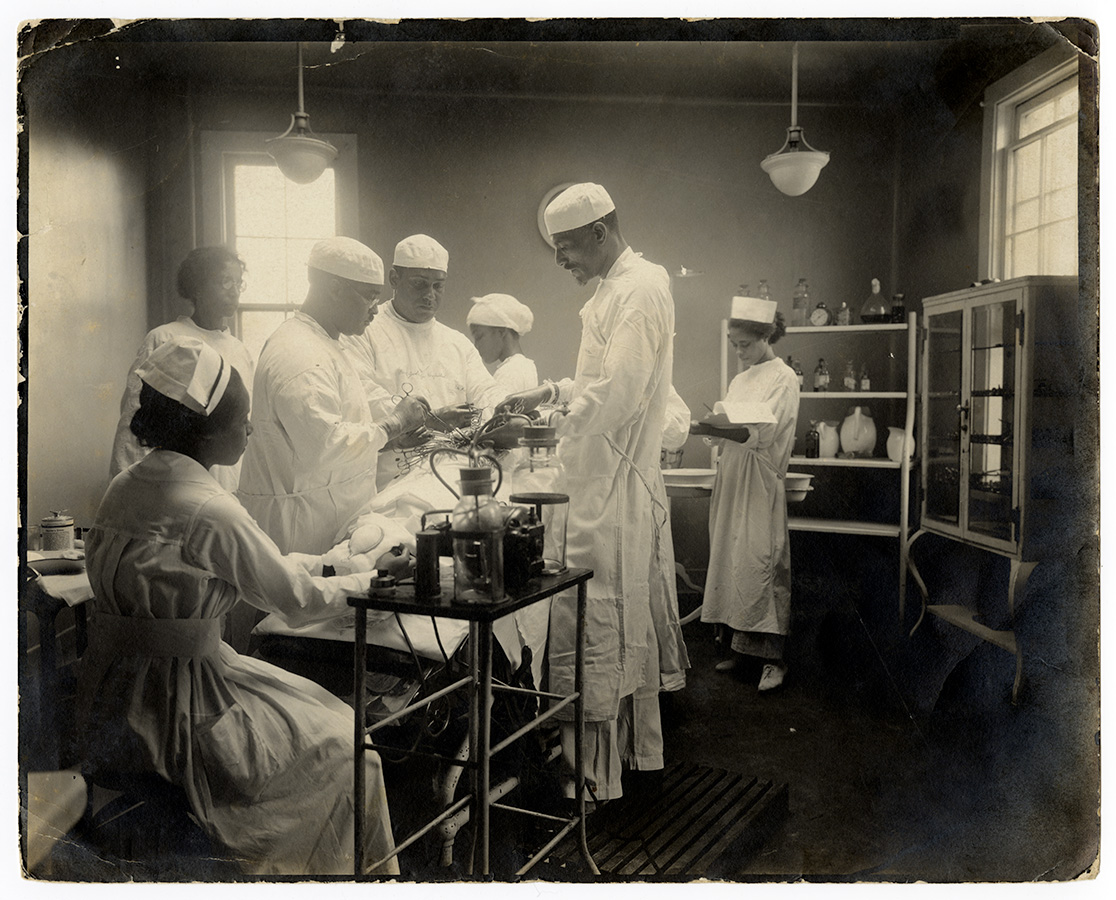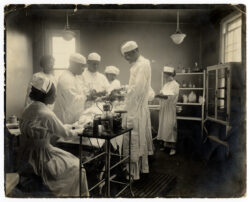Flint-Goodridge Hospital
Flint-Goodridge Hospital opened in 1896 to serve New Orleans’s Black community and provide medical training for Black nurses and physicians at a time when other hospitals denied services to Black people.

Xavier University of Louisiana, Archives & Special Collections
Dr. Rivers Frederick Preforming Surgery at Flint-Goodridge Hospital, undated.
In 1896, the year of the fateful Plessy v. Ferguson Supreme Court ruling, the institution known for most of its eighty-nine-year history as Flint-Goodridge Hospital opened thanks to the efforts of a group of progressive Black women. These women recognized the need for a hospital to serve their community and to provide a training ground for Black nurses and physicians.
The Freedman’s Aid Society of the Methodist Episcopal Church founded New Orleans University in 1873 as a collegiate institution for the mostly newly freed Black population. In 1889 New Orleans University expanded to include a medical college, which graduated its first class in 1892. These graduates were able to set up private practices and generated a great deal of their work servicing the members of benevolent and mutual aid societies, but like elsewhere in the South, they lacked a hospital in which they could complete residencies or in which they had admitting privileges.
Concurrently, a group of civically and socially prominent Black women, including Alice Dunbar-Nelson and public school principal Sylvanie Francoz Williams, founded the Phyllis Wheatley Club of New Orleans. On October 31, 1896, the club opened the Phyllis Wheatley Sanitarium and Training School for Negro Nurses within the building of the New Orleans University Medical College. New Orleans University assumed control of the institution the next year due to financial difficulties for the club.
In 1901 wealthy mill owner John Flint of Fall River, Massachusetts, contributed money to purchase property at 1566 Canal Street to house the newly renamed “Flint Medical College of New Orleans University.” Boston philanthropist Caroline Mudge contributed funds to buy the lot adjacent to the college to serve as the Sarah Goodridge Hospital, named in honor of her mother. The affiliated training program for nurses maintained the name of Phyllis Wheatley. Flint Medical College closed in 1911 after having graduated a total of 116 doctors and forty-eight pharmacists. Flint Medical College, like every Black medical school except Howard and Meharry, was a casualty of the highly critical 1910 Flexner Report. The Carnegie Foundation hired educator Abraham Flexner to survey the nation’s 155 medical schools and recommended the maintenance of only thirty-one schools, including just two for Black medical students. The Canal Street campus continued to operate under the name of Flint-Goodridge Hospital. While Charity Hospital treated low-income patients within New Orleans’s segregated wards, Flint-Goodridge was the only hospital in the city that served Black non-indigent patients. It also provided free and reduced-cost care for low-income patients.
New Orleans University and Straight College, another Black institution of higher education, merged in 1930 to become Dillard University. The work of the hospital continued under the new university, which launched a campaign to raise $2 million for a new hospital building. Along with major donations from Methodists, Congregationalists, and philanthropic foundations, some $328,000 was raised among individual white contributors. The Black community fell short of its $50,000 goal because of the state of the economy due to the Great Depression. On February 1, 1932, the dedication of the new Flint-Goodridge Hospital took place at 2425 Louisiana Avenue. Albert Walter Dent, an insurance executive from Atlanta and alumnus of Morehouse College, became the superintendent of the hospital.
Flint-Goodridge provided employment to nearly every Black physician in the city. During Dent’s nine years at the hospital, he managed to attract white physicians from Tulane and Louisiana State University as consultants and instructors in postgraduate seminars for Black doctors from across the region. This decision was controversial and met with criticism from the local NAACP branch. In the 1930s Flint-Goodridge began offering affordable, flat-rate maternity care to Black mothers, many of whom still sought the less-expensive but often outdated care from midwives. Dent developed an innovative “penny-a-day” medical plan, backed by the philanthropic fund of Sears-Roebuck magnate Julius Rosenwald, which enrolled several thousand patients in its first year. In 1950 the hospital established a much-needed blood bank. This addition was extremely important at a time when the blood banks of most southern hospitals were segregated. In 1953 Flint-Goodridge was placed under the control of a separate Board of Management, removing it from the direct supervision of Dillard’s Board of Trustees. One of the most active board members was noted New Orleans philanthropist Rosa Freeman Keller.
Flint-Goodridge enabled the careers of several generations of Black physicians who otherwise would not have been able to engage in hospital and surgical practice. The hospital’s nursing training program launched the careers of many women who went on to long careers throughout the country and in the South, once mainstream hospitals integrated their nursing staffs.
Like almost all of the parallel institutions developed under Jim Crow, Flint-Goodridge was a victim of the psychological shift after integration in the 1960s. Mainstream hospitals were forced to admit patients of all races and could no longer blatantly exclude Black practitioners from their staffs. Dr. Willie R. Adams, the hospital’s longtime chief of staff, described it bluntly: “Blacks allowed themselves to be brainwashed that white is right. They don’t think that anything Black is worth having.” In addition to losing Black patients to white hospitals, the state denied funding applications and Medicare and Medicaid underpaid for services rendered. For several years before its closure, Doctors’ Hospital Group, Inc.—a group of some fifty-one Black physicians, dentists, and pharmacists led by Dr. Dwight McKenna—attempted to purchase and manage Flint-Goodridge as a physician-owned hospital. Despite these efforts, by May 1985, the new owner, National Medical Enterprises, closed the facility and later donated it to the City of New Orleans.
Since its closure Flint-Goodridge Hospital has been used as affordable housing primarily for seniors and disabled residents. It stands as a tangible reminder of the struggles of Black professionals to practice their craft while uplifting their communities in the nurturing, self-sustaining environments they created and supported during the Jim Crow era.
